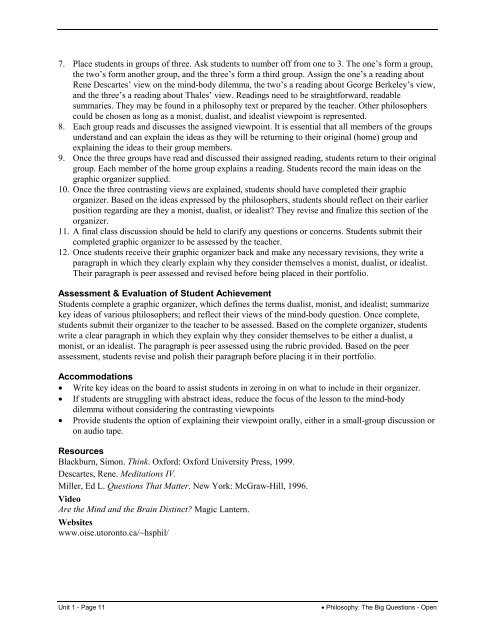Course Profile - Curriculum Services Canada
Course Profile - Curriculum Services Canada
Course Profile - Curriculum Services Canada
Create successful ePaper yourself
Turn your PDF publications into a flip-book with our unique Google optimized e-Paper software.
7. Place students in groups of three. Ask students to number off from one to 3. The one’s form a group,<br />
the two’s form another group, and the three’s form a third group. Assign the one’s a reading about<br />
Rene Descartes’ view on the mind-body dilemma, the two’s a reading about George Berkeley’s view,<br />
and the three’s a reading about Thales’ view. Readings need to be straightforward, readable<br />
summaries. They may be found in a philosophy text or prepared by the teacher. Other philosophers<br />
could be chosen as long as a monist, dualist, and idealist viewpoint is represented.<br />
8. Each group reads and discusses the assigned viewpoint. It is essential that all members of the groups<br />
understand and can explain the ideas as they will be returning to their original (home) group and<br />
explaining the ideas to their group members.<br />
9. Once the three groups have read and discussed their assigned reading, students return to their original<br />
group. Each member of the home group explains a reading. Students record the main ideas on the<br />
graphic organizer supplied.<br />
10. Once the three contrasting views are explained, students should have completed their graphic<br />
organizer. Based on the ideas expressed by the philosophers, students should reflect on their earlier<br />
position regarding are they a monist, dualist, or idealist? They revise and finalize this section of the<br />
organizer.<br />
11. A final class discussion should be held to clarify any questions or concerns. Students submit their<br />
completed graphic organizer to be assessed by the teacher.<br />
12. Once students receive their graphic organizer back and make any necessary revisions, they write a<br />
paragraph in which they clearly explain why they consider themselves a monist, dualist, or idealist.<br />
Their paragraph is peer assessed and revised before being placed in their portfolio.<br />
Assessment & Evaluation of Student Achievement<br />
Students complete a graphic organizer, which defines the terms dualist, monist, and idealist; summarize<br />
key ideas of various philosophers; and reflect their views of the mind-body question. Once complete,<br />
students submit their organizer to the teacher to be assessed. Based on the complete organizer, students<br />
write a clear paragraph in which they explain why they consider themselves to be either a dualist, a<br />
monist, or an idealist. The paragraph is peer assessed using the rubric provided. Based on the peer<br />
assessment, students revise and polish their paragraph before placing it in their portfolio.<br />
Accommodations<br />
• Write key ideas on the board to assist students in zeroing in on what to include in their organizer.<br />
• If students are struggling with abstract ideas, reduce the focus of the lesson to the mind-body<br />
dilemma without considering the contrasting viewpoints<br />
• Provide students the option of explaining their viewpoint orally, either in a small-group discussion or<br />
on audio tape.<br />
Resources<br />
Blackburn, Simon. Think. Oxford: Oxford University Press, 1999.<br />
Descartes, Rene. Meditations IV.<br />
Miller, Ed L. Questions That Matter. New York: McGraw-Hill, 1996.<br />
Video<br />
Are the Mind and the Brain Distinct? Magic Lantern.<br />
Websites<br />
www.oise.utoronto.ca/~hsphil/<br />
Unit 1 - Page 11<br />
• Philosophy: The Big Questions - Open
















